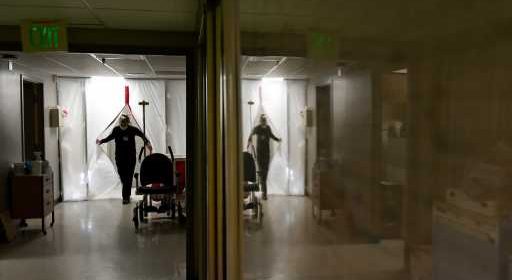False-negative tests let COVID-19 into a rural Colorado hospital’s long-term care unit – The Denver Post

HUGO — On an ordinary day in mid-November, someone woke up feeling fine and went to work at a small-town nursing home on Colorado’s Eastern Plains, as usual.
Two weeks later, all but four of the home’s residents had COVID-19.
Carrie Owens, administrator of Lincoln Community Hospital’s long-term care unit, said she doesn’t know which staff member carried the virus in without showing symptoms. Everyone came up negative on the rapid tests they took in the week before the first resident started feeling unwell, and they hadn’t allowed any visitors.
“It’s just my worst nightmare,” she said, trying to hold back tears. “We’ve done our best to protect these residents.”
Outbreaks in nursing homes accounted for an outsized number of Colorado’s deaths in the first months of the COVID-19 pandemic. Over the summer, such long-term care facilities had a bit of a reprieve, as the virus circulated most in places younger people frequented.
Since spring, federal and state regulators instituted a slate of rules on staff testing, use of protective equipment and activities like group dining, but they haven’t kept the virus out. Colorado reported more nursing home outbreaks this week than during the previous worst point, in May.
The Lincoln Community Hospital nursing home, in Hugo, avoided the first round of outbreaks. All staff underwent rapid tests twice a week and were checked for a fever or other symptoms at the start of each shift, and they had enough surgical masks, Owens said. The facility wasn’t cited for infection control violations in an inspection earlier this year.
Still, 11 of the 15 residents have tested positive in recent weeks, as have 12 staff members. No deaths have been reported, and one resident remains hospitalized.
Testing and protective equipment are easier to get than they were in the spring, but it’s possible a person will test negative, become contagious and spread the virus for as long as a week before another test catches them, said Doug Farmer, president and CEO of the Colorado Health Care Association.
“It’s imperfect,” he said.
Increased spread in nursing homes coincided with a resurgence in the wider community. As of Friday morning, Lincoln County had the highest rate of new infections compared to population of any U.S. county reporting data, with the equivalent of 6,705 cases for every 100,000 people, according to The Washington Post’s tracker.
Dr. John Fox, Lincoln County medical officer and a physician at Lincoln Community Hospital, said people may have developed a false sense of security after being relatively untouched by the virus for months, but there’s no one factor that explains the November spike.
“Our luck ran out,” he said.
Dr. Morgan Katz, an infectious disease physician who specializes in long-term care at Johns Hopkins University School of Medicine, said that since testing isn’t perfect, facilities need to stay vigilant about wearing protective equipment and maintaining distance between residents and staff. It’s challenging, because residents who have cognitive impairment may not understand why they need to wear a mask or may be unable to tell staff they’re feeling off in the first days after infection, she said.
“If that person’s going to group dining for those two presymptomatic days, that’s a lot of people they can spread it to,” she said.
Nina Kohn, a professor specializing in elder law at Syracuse University, said some outbreaks could be avoided if nursing homes had consistent, full-time staff who work with only a few residents. Many caregivers work part-time in multiple facilities, so they can spread the virus widely before realizing they’re sick, she said. Lincoln Community Hospital’s nursing home doesn’t allow staff to work in multiple facilities.
The current set-up in most nursing homes has left residents isolated from those they need most — their families — but still vulnerable to catching the virus from rotating staff, Kohn said.
“Certainly nursing homes are very susceptible to COVID-19, but I don’t think we should see this as inevitable,” she said.
At the nursing home in Hugo, staff responded to the first cases by creating a COVID-19 unit within the nursing home, separated from the other rooms by a plastic barrier. As it became clear how widely the virus had spread, they decided to make the entire nursing home a virus unit, and moved the four residents who don’t have the virus into the hospital wing, at the other end of the H-shaped building, Owens said.
Staff who tested positive but aren’t showing symptoms are back at work with positive patients, she said.
Owens likened living in a community where the virus is spreading to doing an art project with someone who’s using glitter: no matter how hard you try to avoid it, you’ll pick some up. Masks and other restrictions have been a hard sell, both because of the political climate and because people in Lincoln County pride themselves on being self-reliant, she said.
“That became something people want to stand on, but, unfortunately, people are going to die on it,” she said.
Subscribe to bi-weekly newsletter to get health news sent straight to your inbox.
Source: Read Full Article


